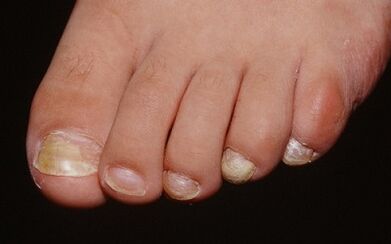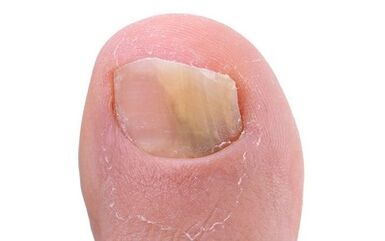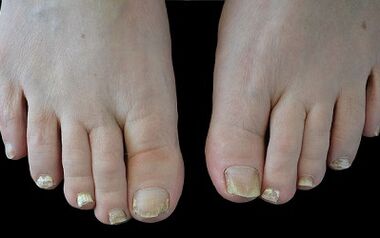
Onicycosis or nail fungus is an infectious disease that can affect the nails of the upper and lower extremities.However, the second option is more likely for several reasons.Especially the fungus affects the thumb nail plate.In such cases, it is important to respond to the problem in time, not give pathology to extend to the skin and other fingers.
For successful treatment, which eliminates the development of complications and relapses in the future, it is necessary to start a fight as soon as possible.For this, it is important to know the clinical image of the disease, understand the main causes of its appearance and development characteristics.Despite the need to see a doctor, it will not be superfluous to understand the principles of treating the fungus of the nails in the thumb of the leg.
The reasons for the appearance of the fungus on the thumb
The most likely location of fungal damage is the nails of the lower extremities.The fact is that the feet are more susceptible to the factors in which the fungus is easier to establish a support point and develop.In addition, the legs are many times more often in a potentially contaminated environment.
At the same time, it is important to know that in approximately 90% of cases the development of onychomycosis begins with the nail in the thumb.
Two main causes of this disease scenario are distinguished:
- The size of the nail plate on the thumb is much larger than in the other fingers.According to this, obeying the simplest probability theory, it is in it that the most pathogens and conditionally pathogenic microorganisms fall on it.Therefore, the probability of the beginning of the pathological process in this area will always be greater.
- Due to the characteristics of the thumb size, as well as its physiological location, it is more subject to trauma.It is with the thumb that people often hit, often step on transport.Due to the fact that one of the main predisposing factors in the development of the nail fungus is the damage to the nail plate, the pattern becomes corroboible and understandable.

If we talk about the causes of onylomycosis in general, the main in medical practice is a decrease in body defenses.Anything can cause a weakening of immunity, by ordinary stress or hypothermia, ending with chronic diseases or even an advanced age of a person.
To protect yourself from the disease, it is necessary to constantly strengthen immunity.But with a set of factors, this may not be enough.
To reduce the number of predisposing factors to a minimum, it is worth considering the most likely:
- The thumb injury, especially often, this happens with the people who work in a construction site or participate in another hard work, as well as with athletes.
- The exhibition of the legs with diapers eruption and excessive sweating in most cases, this is due to the use of inappropriate shoes in which the legs are very sweat and successful.
- Wear uncomfortable or close shoes: the problem of choosing shoes is especially serious.It is recommended to buy high quality shoes, do not walk with high heels for a long time.
- Not fulfilling hygiene: men are especially often sins with this, believing that one of the feet before bedtime is enough.It is important to monitor the nails, cut them and file them in time, use special hygienic lotions and avoid diaper eruption or dry from the skin.
The most common factors are given previously, which are easier to influence, reducing the probability of fungal damage.In general, it is also recommended to observe the daily routine, eat completely, as little as possible.
Important!Due to the fact that one of the main reasons for the appearance of the fungus in the thumb is the advanced age, the elderly must be especially careful.To strengthen the body, it is important to constantly undergo chronic diseases, to regularly visit a doctor, it is possible to periodically submit vitamin therapy to strengthen immunity.
Clinical image of the disease
Even the initial symptoms of the fungus of the nails on the thumb are easier to detect than in the other fingers.This is explained by the same physiological characteristics of the structure.

Due to the size of the finger, even the initial manifestations of the disease are easier to see in it.
At the same time, to detect the development of pathology over time and take appropriate measures over time, it is important to know the especially clinical image of the early stage of onychomycosis:
- White spots, points or stripes appear in the nail.Initially, they have a small size, in the future they increase, merging.
- The nail loses its natural brightness, it becomes mate, sometimes rough, without visible reasons.
- The nail plate gradually changes color, at first it becomes yellowish or light brown
- Initial structural disorders can be invisible.The nail plate usually hard of the thumb becomes soft or fragile.Of the most obvious symptoms, cracks and grooves appear on the surface of the nail, its outer (free) edge is slightly exfolia.
- Already in the early stages of the progression of the pathological process, a person can feel itching in the thumbnail of the thumb.At the same time, the skin around becomes rough, dry, capable of lining.
To notice the initial symptoms, it is important to be very attentive at your feet and regularly lead to hygiene procedures.This applies to all clinical signs, with the exception of itching, which no longer goes unnoticed.
In the absence of timely treatment, the disease is slow, but still progresses.At the same time, the clinical image changes more different, ignoring the problem is more difficult.
The symptoms of thumb onychomycosis on a later date acquire the following characteristics:
- Itching appears in the first or improvement, this symptom is constant, as well as intensity.If the legs are successful or sweat, the thumb is shy with the shoes, the itching intensifies.
- There is a change in the color of the nail, now acquires green, brown or even black.At the same time, the white spots that appear previously expand and merge.
- Due to the fact that the fungus penetrates deeper, structural disorders aggravate.The belly of the nail plate, its tuberosity and cracks become deeper.The increase in softness is replaced by fragility, the nail literally falls apart.The stratification process affects not only the outside of the nail plate, but extends throughout the area and depth, which only exacerbates destruction.
Important!In the appointment with the doctor, visually the doctor can only determine approximately the stage of progression of the disease and assume what the pathogens are.To make a precise diagnosis, a complete diagnosis is required.The same applies to the early stages when the symptoms are invisible to the doctor, but complaints come from the patient.
Traditional Treatment of fungi damage

Like symptoms, the characteristics of the treatment of the disease depend on which the fungus caused onychomycosis, as well as at what stage the treatment has begun.If it detects the fungus in the thumbn nail in the latch, the duration of the therapy is significantly reduced and it is very likely to do with local external medications.
We are talking about ointments, gels, varnish, aerosols or drops with antimicotic activity.These medications apply directly to the affected nail, sometimes to the surrounding areas of the skin.In most cases, these medications are effective in relation to a wide range of fungi.
If you cannot get rid of the fungus with external medications or the patient consults a doctor in the late stage of disease progression, complex therapy is required.To local medicines for the treatment of nail fungus in the thumb, are added systemic, which are taken orally and affect the pathogen from the inside.
Treatment with popular methods
In popular medicine, there are a lot of ways to treat the fungus in a large nail.These include lotions, bathrooms, cleaning and ointments based on natural components or improvised media with antifungal activity.
Among the most popular and effective recipes are:
- The use of vinegar or iodine: both substances have prisons pronounced antiseptic properties.Fogging a cotton pad in iodine or vinegar, then cleaning the nail plate 2-3 times a day, you can achieve the desired result, the death of the fungus.Such manipulations are made within 3-4 weeks per day.
- Salt baths: Dilute in two liters of hot water 2 tablespoons of salt or table salt.To cook your legs for 15-20 minutes before bedtime, don't wash, let the legs dry.The procedure is carried out daily for 2-3 weeks.
There are many similar methods, but the use of even the most harmless, requires mandatory doctors.
Important!Traditional medicine is effective in the fight against fungal damage to nail plates only in the early stages of pathology development.In other cases, popular recipes are used only as an auxiliary treatment that complements pharmacological therapy or as a prevention.























